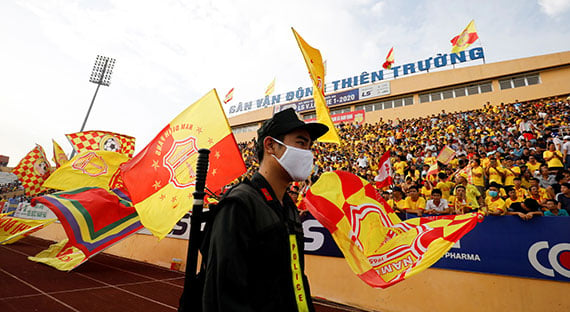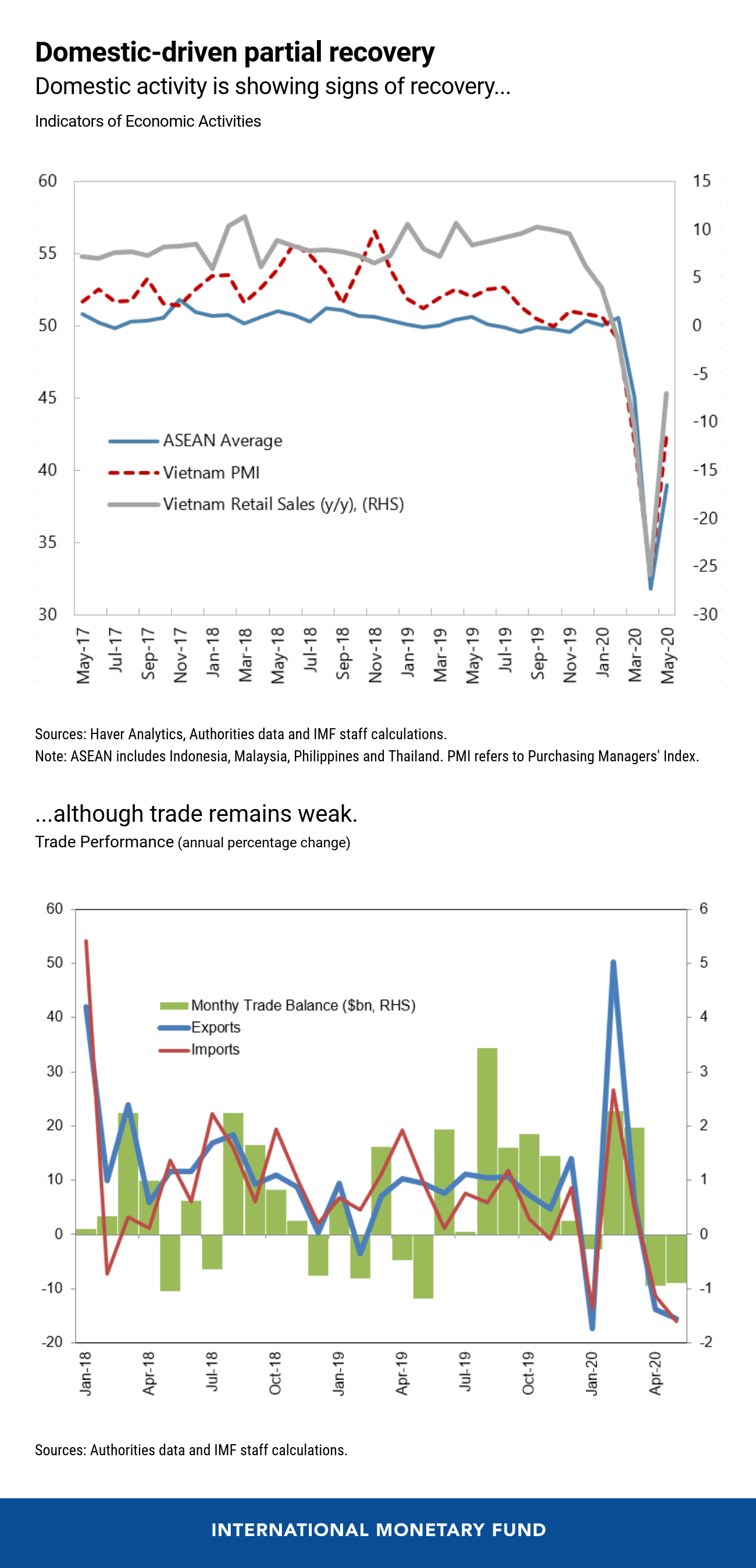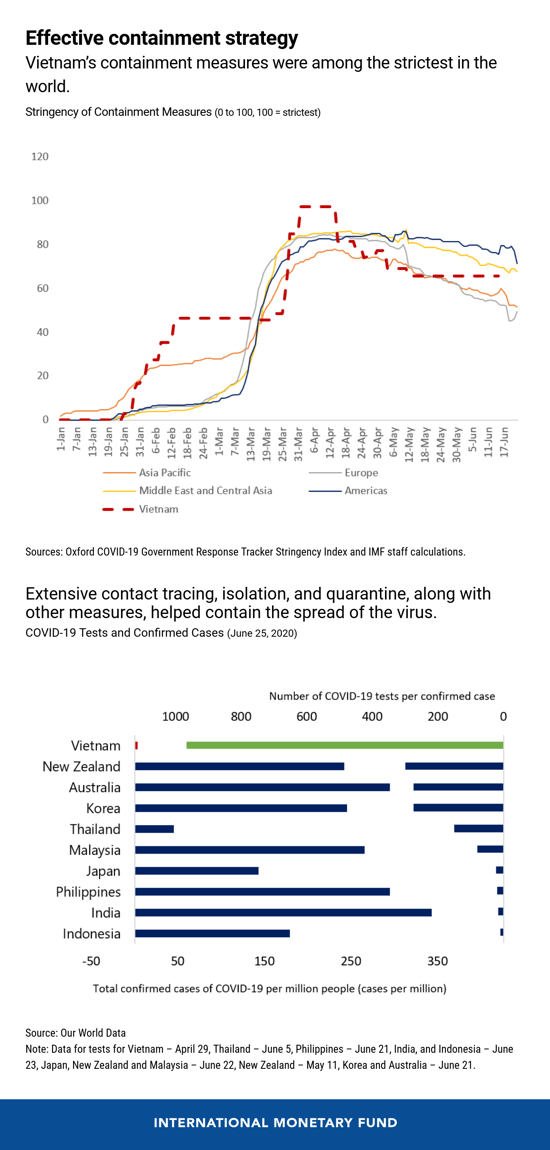
A police officer walks past soccer fans at a match in early June, after the Vietnamese government eased a nationwide lockdown following the COVID-19 outbreak. (photo: Reuters/Kham)
Vietnam's Success in Containing COVID-19 Offers Roadmap for Other Developing Countries
June 29, 2020
The father of the Vietnamese nation, Ho Chi Minh, once noted that: “The storm is a good opportunity for the pine and the cypress to show their strength and their stability.” Vietnam has so far shown strength and stability in weathering the COVID-19 storm, and offers a successful example of how a developing country can fight a pandemic.
While its economy has suffered a significant blow due to weakened demand and reduced trade, the effective containment strategy should allow for a quicker rebound.
At the outset, it was expected to be an uphill battle. Vietnam was regarded as highly vulnerable, given its long border and extensive trade with China, densely populated urban areas, and limited healthcare infrastructure. But Vietnam’s cost-effective containment strategy resulted in only 352 confirmed cases and no deaths in a population of almost 100 million people. The country was among the first to lift virtually all domestic containment measures.
Related Links
Vietnam’s successful strategy was informed by its experience with previous outbreaks, like the Severe Acute Respiratory Syndrome, or SARS, in 2003. Early on, the Prime Minister prioritized health above economic concerns. The strategy was swiftly deployed with the help of the military, public security services, and grass-root organizations, which speaks to some features unique to Vietnam. Effective and transparent communications won the population’s buy-in, and contains broader lessons for developing countries.
Reaping the containment dividend
Vietnam successfully limited the spread of COVID-19 so far, but it will not be immune to its economic impact. Weaker domestic and external demand is expected to slow growth significantly from 7 percent in recent years to 2.7 percent in 2020.
However, the economic impact is expected to be milder than most countries in the region. Prospects for a recovery look bright as lockdown measures have been lifted, businesses resume operations, and consumers flock to restaurants and shops. There are tentative signs of a domestic recovery, with retail sales and industrial production rebounding from low points seen during the lockdown. But sustained and robust growth will also require an economic recovery among Vietnam’s trading partners.

Rapid introduction of containment measures
Soon after China officially reported to the World Health Organization (WHO) several cases of an unusual pneumonia on December 31, 2019, Vietnam finalized a health risk assessment. By January 21, the Ministry of Health had issued guidance on outbreak prevention and detection. Before the end of January, Vietnam had issued its National Response Plan and established a National Steering Committee on Epidemic Prevention. This was critical to coordinate the actions and communications of relevant actors at different levels of governments.
Strict containment measures were gradually adopted, including airport health screenings, physical distancing, travel bans on foreign visitors, a 14-day quarantine period for international arrivals, school closures, and public event cancellations. Wearing of masks at public venues was strictly enforced, even before the WHO recommendation, along with requiring hand sanitizers in public areas, workplaces, and residential buildings. Non-essential services were shut down nationwide, and strict restrictions on movements imposed across most of the country for 3 weeks in early April.
Aggressive and cost-effective control measures
While a higher-cost, mass-testing strategy was adopted in most advanced economies to combat the pandemic, Vietnam focused on high-risk and suspected cases and conducted only 350,000 tests, a relatively small share of its population. However, around 1,000 people per confirmed case were tested, the highest ratio in the world.
In parallel, Vietnam used extensive contact tracing, isolation and quarantining, up to third-tier contacts. Groups of people who lived near confirmed cases, sometimes an entire street or village, were swiftly tested and isolated, which helped limit community transmission. Nearly 450,000 people have been quarantined (either at hospitals or state-run facilities or self-isolation). Treatment and quarantine in hospitals were provided free of charge for Vietnamese.
Early containment and use of existing public and military facilities proved to be cost effective. The government estimated the budgetary cost of fighting the pandemic at about 0.2 percent of GDP, with about 60 percent spent on equipment, and the rest on containment activities.
Whole-of-society fight
Public buy-in was critical for success. From an early stage, communications about the virus and the strategy were transparent. Details on symptoms, protective measures, and testing sites were communicated through mass media, a government website, public grass-root organizations, posters at hospitals, offices, residential buildings and markets, via text messages on mobile phones, and as voice messages before a phone call could be made. The government also launched a contact tracing app in big cities. This well-coordinated multi-media approach strengthened public trust and helped society adhere to protective and containment measures.



